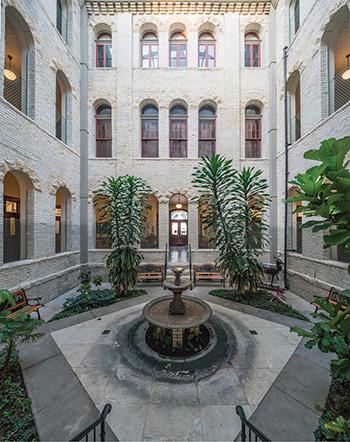By Andy Rhodes, Managing Editor The Medallion, Photos by Patrick Hughey
Texas’ historic courthouses are among the state’s most widely recognized and valued assets. Their classical copper domes, lofty towers, and stately silhouettes punctuate the skylines of many counties, luring travelers to explore historic downtown districts.
The Texas Historical Commission’s (THC) Texas Historic Courthouse Preservation Program (THCPP) is protecting these iconic structures in communities throughout the state by offering grants to counties that help preserve their historic courthouses. In the process, Texas is providing a cost-effective example about utilizing existing assets, refocusing community pride, and maximizing the return on historic civic buildings in county seats.

The THCPP provides the incentive for counties to invest matching funds to ensure their courthouses will always be safe, energy efficient, and inspiring places to visit and conduct government business. Program participants experience many benefits, such as improving functionality and creating a tangible link to the past.
Since the program’s inception in 1999, 73 county courthouses have received full restoration funding, and 30 counties have received emergency and/or planning grants while awaiting major construction funds. So far, the THCPP has attracted 146 participants, and awarded over $310 million to 103 counties or municipalities.
Meanwhile, 43 other program participants have not received any funding at all, with a total outstanding need among participants of over $550 million.
In addition to providing safe and functional buildings, restored historic courthouses benefit the state and local economies. Courthouse preservation projects have created more than 11,800 jobs in Texas and generated nearly $690 million in revenue, and almost $850 million in gross state product.
The economic impact has been especially significant in Texas’ rural communities, where courthouses often anchor a historic downtown district, and the associated heritage travelers—who spend more than average—bring money to the community. Restored courthouses reinvigorate historic downtowns and promote heritage tourism, which generated $7.8 billion in state and local taxes in 2019, according to the Office of the Governor–Economic Development and Tourism.
Preservation Provides Dividends

The THCPP also serves as a catalyst that encourages additional public and private investment in historic downtowns. When a courthouse project begins, vacant buildings in the central commercial district often dwindle by the project’s completion.
“Preserving Texas’ historic courthouses is an investment that offers immediate returns while paying dividends to the citizens of tomorrow,” says Bess Althaus Graham, director of the THC’s Architecture Division. “There aren’t many places that can strengthen and transform an entire community like a restored cherished courthouse.”
In 2005, the THC developed the Texas Courthouse Stewardship Program to prevent these state landmarks from returning to a state of decay or deterioration.
“After restoration, these buildings need to be cared for to prevent them from falling back into disrepair,” Graham says. “Stewardship is an important ongoing effort for any historic building.”
As part of the stewardship program, THC reviewers help counties by offering professional advice on how to best preserve the buildings. Useful information is also available at the Courthouse Stewardship Program, where county staff can access the Courthouse Maintenance Handbook and other resources on courthouse components and systems. These reference materials are valuable tools, allowing county staff to plan for budgeting and construction projects.
Courthouse Preservation Program reviewers can also assist counties with developing a cyclical maintenance plan for immediate and long-term care of their historic buildings and sites. The program provides additional guidance by offering preservation resources, preventive maintenance checklists, sample templates for schedules, budget formats, and inspection forms.
This assistance has been bolstered by important statewide partnerships. The THC and the Texas Land Title Association, a statewide member-based trade organization for title agents, developed an annual workshop series in 2007 for the stewardship program and regional training workshops. This initiative provides assistance and training for county officials and facilities managers with an emphasis on a commitment to routine maintenance programs.
Grants Announced
In June 2020, the THC announced grant recipients for Round XI of the THCPP. The THC awarded matching grants totaling $20,038,121 to nine counties, including three grants for full restorations.

Callahan, Mason, and Taylor counties received construction grants for full restorations.
Kimble, Washington, Willacy, and Wise counties received planning grants to be applied toward the production of construction documents for a future application to the THCPP for full restoration of their courthouses. Duval and Lee counties received emergency grants to address critical issues, including the replacement of an original electrical system and foundation repairs.
“Preserving our Texas courthouses has always been a priority for the THC,” said THC Executive Director Mark Wolfe. “Our courthouse grants help counties maintain essential state services and offer centerpieces of history and culture for visitors to enjoy.”
The THCPP Round XI grants were made possible through a $25 million appropriation by the 86th Texas Legislature. Over $2.5 million of those funds were distributed last year to counties with unforeseen conditions, in the form of supplemental funding.
The THC received applications from 21 counties requesting over $100 million in grants for projects totaling over $175 million. The agency determined grant awards by assessing 22 criteria, including the building’s age, endangerment, historical designations, the applicants’ project proposals, local support for the project, and a new scoring criterion that assesses an applicant’s ability to contribute financially toward the project.
This new criterion, county revenue, gives applicants with lower revenues more points than applicants with higher revenues. Emergency grants were based primarily upon the score assigned to the endangerment category.

